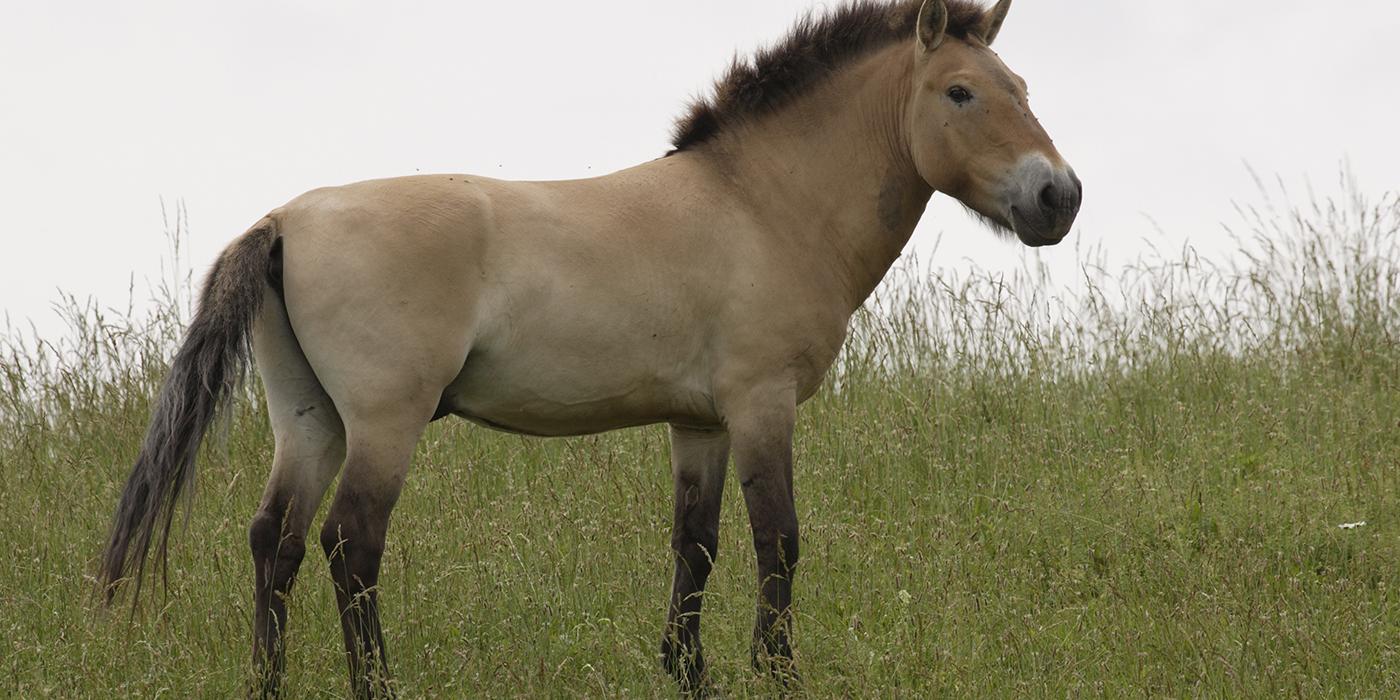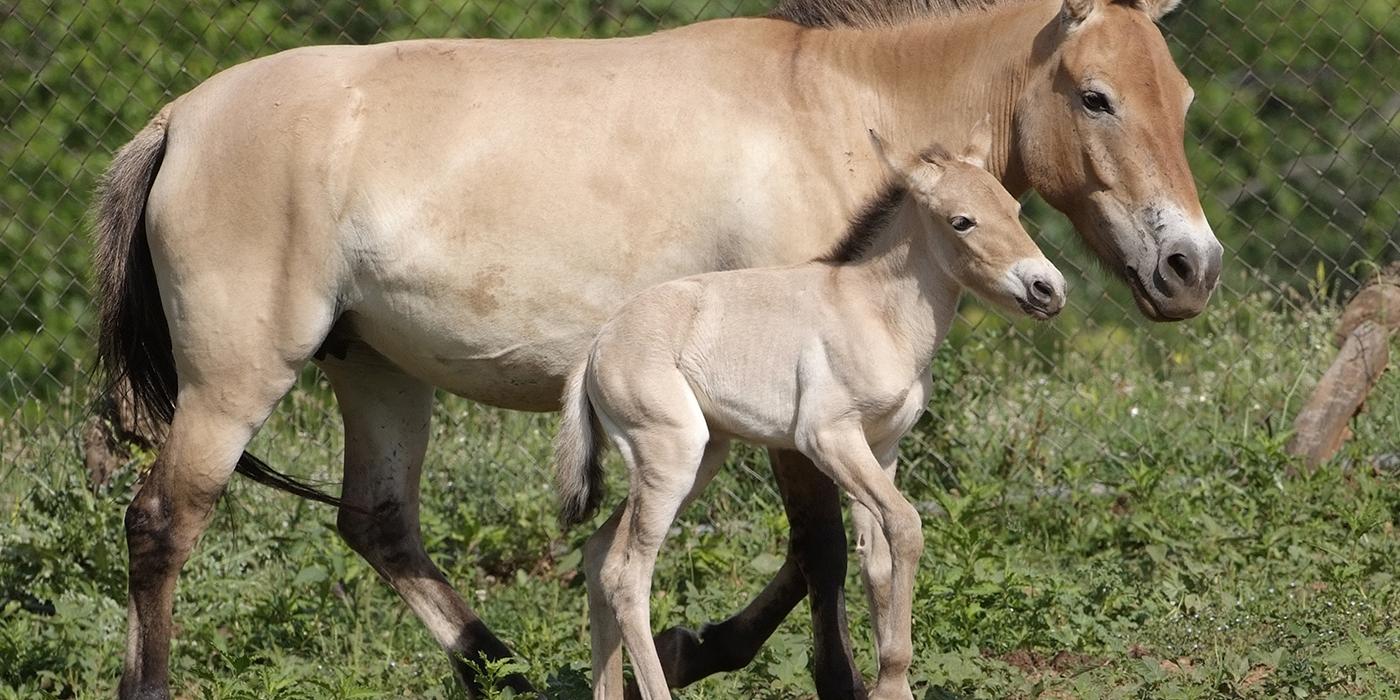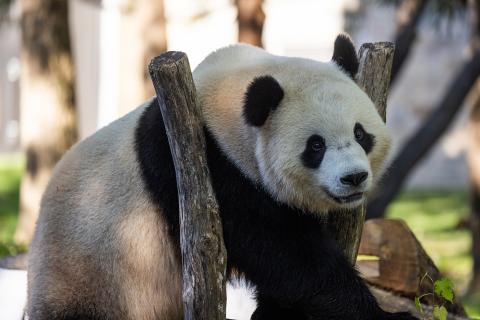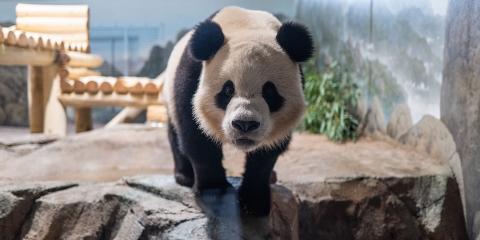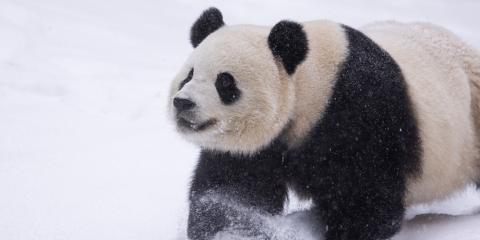Physical Description
Przewalski's horses are often described as small and stocky. They are heavily built, with a large head, thick neck and short legs. They are dun-colored with a dark zebra-like erect mane and no forelock. A dark stripe continues from the mane along the backbone to a dark, plumed tail. They have a yellowish-white belly and dark lower legs and zebra-like stripes behind their knees.
Size
Przewalski's horses are 4.3 to 5 feet (1.3 to 1.5 meters) tall at the withers, 7.25 to 8.5 feet (2.2 to 2.6 meters) long and weigh 550 to 800 pounds (250 to 360 kilograms).
Native Habitat
Przewalski's horses once ranged throughout Europe and Asia. Competition with man and livestock, as well as changes in the environment, led to the horse moving east to Asia, and eventually becoming extinct in the wild. Today they can only be found in reintroduction sites in Mongolia, China, and Kazakhstan.
Przewalski's horses are the only wild horses left in the world. The "wild" horses that abound in Australia and North America's western plains and East Coast barrier islands are actually feral domestic horses that escaped from ranches and farms and returned to the wild.
Przewalski's horses were last found on the Mongolian steppes of the Gobi Desert. The Gobi is different from the Sahara, as only a tiny part of it is sandy desert. It is extremely dry, but the region also has springs, steppes, forests, and high mountains, and supports a great diversity of animals. The steppe of Mongolia may represent the greatest expanse of largely unaltered grassland in the world. Mongolia is an Alaska-sized country sandwiched between China and the former Soviet Union. It is a land of extremes, as summer temperatures can soar to 104° Fahrenheit (40° C) while winter temperatures can plunge to 50 below zero (-28° C).
Lifespan
Przewalski's horses may live up to 36 years of age.
Food/Eating Habits
In the wild, Przewalski's horses graze on grass and leaves from shrubby trees. Like zebras and donkeys, they are hind-gut fermenters, meaning that they need to consume large amounts of water and low quality food.
Mares at the Smithsonian Conservation Biology Institute graze on pasture a few hours a day.
Social Structure
This species often lives in groups that contain several mares, a dominant stallion, and their offspring. There may also be younger stallions on the periphery of the herd or in a bachelor herd. These young stallions will only be allowed to breed if they defeat the dominant stallion. Once offspring reach breeding age, they are chased out of the herd.
Reproduction and Development
Domestic horses are seasonal breeders that cycle in the spring and summer. Very little is known about the reproductive physiology of Przewalski's horses; a research program at the Smithsonian Conservation Biology Institute is looking into many aspects of female and male reproductive physiology. This has become very important as many zoos in North America are reporting infertility issues and, as a result, not many foals have been born in the last ten years.
Conservation Efforts
Przewalski’s horses have long been considered the last surviving wild horse species, but a recent study has raised speculations. The new data highlights a close genetic relationship between Przewalski’s horses and Botai horses, the latter of which some scientists consider to be the first domesticated species. They point to this relationship as evidence that Przewalski’s horses may have been domesticated.
However, Botai horses form a clade (or group of organisms with a common ancestor) distinct from domestic horses, meaning it is possible that Botai horses were tamed but not domesticated. Asian elephants offer a modern illustration of this distinction, as they have been tamed for use as draft and war animals for thousands of years but are not domesticated animals.
There is no strong evidence that Przewalski’s horses are feral descendants of domestic ancestors. Rather, they are unique descendants of horses within the Botai/Borly clade and represent genetic diversity that is no longer found among horses. As such, Przewalski’s horses remain the “best of the rest” of the true wild horses.
These horses ranged freely in wild populations well into the 20th century and are integral to a healthy steppe ecosystem. Their restoration and conservation continues to be a significant goal for global conservation and for preserving what remains of the world’s ancient wild horses.
Prior to reintroduction programs, Przewalski's horses were last seen in the wild during the 1960s in the Gobi Desert, which accounts for roughly the southern third of Mongolia. The number of Przewalski's horses dwindled due to human interference, including cultural and political changes, as well as military presence, poaching and capture. Today, their primary threats include habitat degradation, climate change, low genetic diversity, hybridizing and disease transmission. The loss of habitat is mainly due to to illegal mining and military disturbances.
Through breeding programs, Zoos have been instrumental in preventing the Przewalski's horse from dying out altogether. Of the approximately 1,900 Przewalski's horses alive today, all are descended from 14 founders that were caught in the wild between 1910 and 1960. The Smithsonian's National Zoo and Conservation Biology Institute is heavily involved in saving Przewalski's horses, including through reproductive research, genetic management of the North American herd, global genetic management, reintroduction and capacity building.
Species that are reduced to such small populations can lose much of their genetic diversity, which in turn can make adults less fertile and young less likely to survive. The species went through a second round of bottlenecking during World War II. In 1945, there were once again less than 20 breeding Przewalski's horses in the world. An international studbook was established in 1959, which later became the Species Survival Plan.
Przewalski's horses are legally protected in Mongolia, where hunting has been prohibited since 1930. Three ongoing reintroduction sites are being monitored in Mongolia, including community integration and support. Despite the efforts already in place, there is still a need for better disease monitoring, separation between Przewalski's horses and domestic horses, streamlined population management, a better plan for Mongolia (home to the only wild population), genetic mapping of existing Przewalski's horses, addressing the concern of hybrids, training and education for those in the field.
Help this Species
- Support organizations like the Smithsonian’s National Zoo and Conservation Biology Institute that research better ways to protect and care for this animal and other endangered species. Consider donating your time, money or goods.
- Share the story of this animal with others. Simply raising awareness about this species can contribute to its overall protection.
